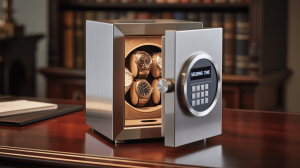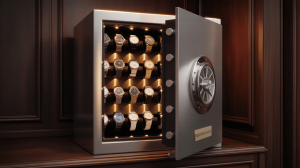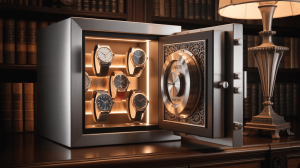Watch Safes for Sale: Ultimate Guide to Choosing the Right One. But here’s the kicker… Your timepieces deserve specialized protection—this guide walks you through every feature, style, and budget point to find the perfect vault.
1. Determine Your Security Needs
Assess local theft and fire risk. Look for UL RSC or ETL burglary ratings and UL 72 Class 350 fire ratings. Consider mechanical dials for power-free reliability or electronic keypads for multiple user codes. Bolting options—floor or wall—add theft deterrence.
| Certification | Standard | Protection Level |
|---|---|---|
| UL RSC | Burglary resistance | 5–10 min forced-entry delay |
| UL 72 Class 350 | 30 min @1,200 °F fire test | Keeps interior below 350 °F |
2. Match Size to Your Collection
Inventory your watches and any jewelry. Allocate ~2 inches width and 1.5 inches height per watch pillow plus trays for gems or straps. Include 20–30% extra space for future additions.
3. Choose Exterior Materials and Finish
Safes come in powder-coat steel, brushed stainless, wood veneer, or leather wrap. Matte black steel suits modern decors; walnut veneer fits traditional rooms. Verify corrosion resistance in humid environments.
4. Evaluate Lock Mechanisms
Decide between mechanical combo locks, electronic keypads, or biometric scanners. Dual-lock models combine two methods. Time-delay features and audit logs add extra security against brute-force attempts.
| Lock Type | Power Need | Key Benefit |
|---|---|---|
| Mechanical Dial | None | Always functional |
| Electronic Keypad | Batteries/AC | Multiple codes + logs |
| Biometric Scanner | Batteries | Instant fingerprint access |
5. Consider Fire and Moisture Seals
Intumescent gaskets expand under heat to seal gaps; composite fireboards slow heat transfer. IP54-rated door seals block dust and light moisture, preserving lubricants and gemstones.
6. Interior Organization Options
Modular foam inserts, velvet watch pillows, ring rolls, and necklace hooks prevent scratches and tangles. Removable winder modules convert storage bays for automatics when needed.
7. Decide on Watch Winder Features
Premium safes offer adjustable TPD (650–2,000), directional control (CW, CCW, bi-directional), and pause intervals to prevent over-winding. Quiet motors (< 25 dB) and removable trays enhance versatility.
| Winder Spec | Range/Feature | Benefit |
|---|---|---|
| TPD Range | 650–2,000 | Matches manufacturer specs |
| Direction Modes | CW, CCW, bi-directional | Prevents mechanical stress |
8. Assess Smart Connectivity
Bluetooth or Wi-Fi safes send tamper, door-open, and low-battery alerts to your phone. Apps enable remote lock/unlock, winder adjustments, and audit-trail reviews for total oversight.
9. Check Power and Backup Systems
Dual-power designs use AC adapters plus rechargeable batteries or USB-C trickle charging. Low-battery alerts and mechanical override keys ensure you never lose access.
10. Noise and Vibration Control
Look for rubber-damped motor mounts and precision bearings keeping noise under 25 dB. Soft-close hinges eliminate slamming; smooth bolt engagement prevents clicks.
| Component | Noise Rating | Advantage |
|---|---|---|
| Motor Mounts | Rubber-dampened | Minimizes vibration |
| Soft-Close Hinges | Hydraulic design | Silent operation |
11. Installation and Anchoring
Bolt safes into studs or concrete with heavy-duty sleeve or lag anchors. Level the unit before tightening to prevent binding. Conceal anchor plates under interior liners for a seamless look.
12. Compare Budget vs. Features
Entry-level safes ($100–$300) cover basic security; mid-range ($300–$700) adds fire ratings and winders; premium ($700+) delivers biometrics, smart apps, and luxury finishes. Prioritize core certifications over extras.
13. Verify Warranty and Support
Look for 3–5 year warranties on structure and electronics. Check for onsite service, spare parts, and responsive customer support to handle repairs or questions swiftly.
| Warranty Type | Duration | Coverage |
|---|---|---|
| Standard | 1–2 years | Parts and labor |
| Extended | 3–5 years | Electronics + onsite service |
14. Read Reviews and Test Models
Before purchase, read user feedback on noise levels, build quality, and support. If possible, inspect showroom units to verify lock feel, finish, and interior layout.
15. Final Selection Checklist
Compile criteria—capacity, burglary/fire ratings, lock type, organization, winders, connectivity, power, noise, finish, installation, warranty, and budget—into a comparison chart. Score top models to choose the best fit.
Conclusion
Choosing the right watch safe means balancing security, functionality, and style. Here’s the deal… follow this guide to find a trusted vault that protects your timepieces and complements your décor.
FAQ
Q1: What burglary rating matters most?
UL RSC or ETL certifications ensure proven forced-entry resistance.
Q2: Do all safes include winders?
No—verify modular winder options before purchase.
Q3: How often replace batteries?
Annually for locks; quarterly for winders under heavy use.
Q4: Are smart features secure?
Use encrypted connections and strong passwords to protect remote access.
Q5: Can I expand interior modules later?
Many brands offer add-on trays and inserts for future growth.







